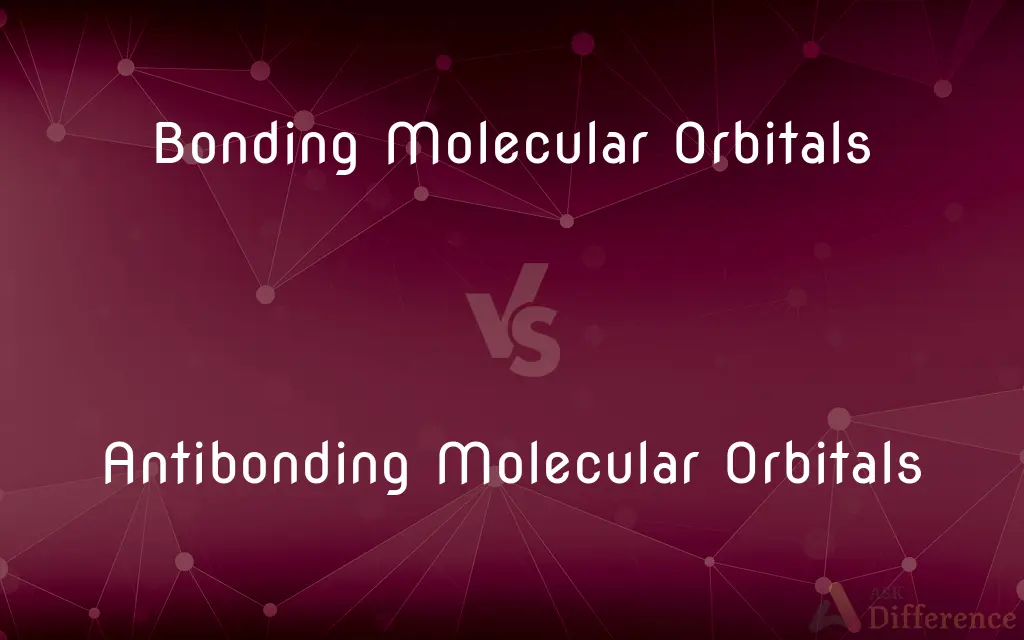Bonding Molecular Orbitals vs. Antibonding Molecular Orbitals — What's the Difference?
Edited by Tayyaba Rehman — By Fiza Rafique — Published on December 8, 2023
Bonding Molecular Orbitals result from the constructive overlap of atomic orbitals, stabilizing the molecule, whereas Antibonding Molecular Orbitals arise from destructive overlap, opposing bond formation. Both contribute to molecular structure.

Difference Between Bonding Molecular Orbitals and Antibonding Molecular Orbitals
Table of Contents
ADVERTISEMENT
Key Differences
Bonding Molecular Orbitals and Antibonding Molecular Orbitals are foundational concepts in molecular orbital theory. Bonding Molecular Orbitals are formed when atomic orbitals combine constructively, leading to regions of increased electron density between the nuclei. On the contrary, Antibonding Molecular Orbitals result from the destructive combination of atomic orbitals, producing regions where electron density is diminished.
The formation of Bonding Molecular Orbitals generally results in the stabilization of the molecule, as they are lower in energy compared to the individual atomic orbitals from which they arise. In stark contrast, Antibonding Molecular Orbitals are of higher energy than the original atomic orbitals, implying that they can destabilize the molecule if populated with electrons.
Electrons in Bonding Molecular Orbitals contribute directly to the bond strength of a molecule, reinforcing the connection between atoms. However, electrons present in Antibonding Molecular Orbitals act in opposition to this bonding effect. Essentially, they counteract the stabilizing influence of the bonding electrons.
It's essential to understand that both Bonding Molecular Orbitals and Antibonding Molecular Orbitals are critical for explaining the electronic structure of molecules. The difference in energy between them, often termed the bond order, can predict the strength and stability of a bond. A molecule will be more stable if there are more electrons in Bonding Molecular Orbitals than in Antibonding Molecular Orbitals.
In spectroscopy, transitions between Bonding Molecular Orbitals and Antibonding Molecular Orbitals can provide insight into molecular properties. While both types of orbitals play distinct roles, they collectively elucidate the behavior of electrons in molecules and the nature of chemical bonds.
ADVERTISEMENT
Comparison Chart
Orbital Formation
Constructive overlap of atomic orbitals
Destructive overlap of atomic orbitals
Energy Level
Lower than the original atomic orbitals
Higher than the original atomic orbitals
Electron Density
Increased between atomic nuclei
Diminished between atomic nuclei
Contribution to Bonding
Stabilizing the molecule
Opposing bond formation
Effect on Molecular Stability
More electrons enhance stability
More electrons reduce stability
Compare with Definitions
Bonding Molecular Orbitals
Bonding Molecular Orbitals arise from the constructive interference of atomic orbitals.
In H2 molecule, the combination of hydrogen atom orbitals forms a Bonding Molecular Orbital, explaining the bond between the hydrogen atoms.
Antibonding Molecular Orbitals
Antibonding Molecular Orbitals form due to the destructive interference of atomic orbitals.
In the He2 molecule, electrons in the Antibonding Molecular Orbital prevent bond formation between helium atoms.
Bonding Molecular Orbitals
They play a direct role in the stabilization of molecules.
The covalent bond in Cl2 is due to electrons occupying Bonding Molecular Orbitals.
Antibonding Molecular Orbitals
They possess higher energy than the atomic orbitals from which they originate.
Electrons will occupy Antibonding Molecular Orbitals only if lower energy Bonding Molecular Orbitals are already filled.
Bonding Molecular Orbitals
Such orbitals are generally of lower energy than the atomic orbitals from which they form.
Electrons prefer to be in Bonding Molecular Orbitals as they offer a more stable, lower energy state.
Antibonding Molecular Orbitals
Electrons in these orbitals can destabilize a molecule.
Excessive electrons in Antibonding Molecular Orbitals can lead to bond breaking.
Bonding Molecular Orbitals
Electrons in these orbitals contribute positively to bond formation.
Double bonds contain more Bonding Molecular Orbitals than single bonds, making them stronger.
Antibonding Molecular Orbitals
These orbitals are characterized by regions of decreased electron density between nuclei.
The presence of electrons in Antibonding Molecular Orbitals can explain the weaker bonding in some molecules.
Bonding Molecular Orbitals
They are regions of heightened electron density between atomic nuclei.
Bonding Molecular Orbitals in H2O contribute to the strong covalent bonds between oxygen and hydrogen.
Antibonding Molecular Orbitals
These orbitals act in opposition to the bond-forming influence of Bonding Molecular Orbitals.
A molecule with an equal number of electrons in Bonding and Antibonding Molecular Orbitals may not exist due to lack of net bonding effect.
Common Curiosities
Can a molecule exist without any Antibonding Molecular Orbitals?
Every Bonding Molecular Orbital has a corresponding Antibonding Molecular Orbital, but it might not always be populated with electrons.
How does bond order relate to these orbitals?
Bond order indicates the difference between the number of electrons in Bonding and Antibonding Molecular Orbitals, predicting bond strength.
How do Antibonding Molecular Orbitals impact molecular stability?
Electrons in Antibonding Molecular Orbitals can destabilize a molecule, opposing bond formation.
What leads to the formation of Bonding Molecular Orbitals?
Bonding Molecular Orbitals form from the constructive overlap of atomic orbitals.
What role do electrons in Bonding Molecular Orbitals play?
Electrons in Bonding Molecular Orbitals contribute to bond formation and molecular stabilization.
Which has higher energy: Bonding or Antibonding Molecular Orbitals?
Antibonding Molecular Orbitals have higher energy compared to Bonding Molecular Orbitals.
Why are some bonds weaker despite having more electrons?
If more electrons populate Antibonding Molecular Orbitals, it can weaken or negate the bond despite the presence of many electrons.
Share Your Discovery

Previous Comparison
Sebamed vs. Cetaphil
Next Comparison
Combinational Circuit vs. Sequential CircuitAuthor Spotlight
Written by
Fiza RafiqueFiza Rafique is a skilled content writer at AskDifference.com, where she meticulously refines and enhances written pieces. Drawing from her vast editorial expertise, Fiza ensures clarity, accuracy, and precision in every article. Passionate about language, she continually seeks to elevate the quality of content for readers worldwide.
Edited by
Tayyaba RehmanTayyaba Rehman is a distinguished writer, currently serving as a primary contributor to askdifference.com. As a researcher in semantics and etymology, Tayyaba's passion for the complexity of languages and their distinctions has found a perfect home on the platform. Tayyaba delves into the intricacies of language, distinguishing between commonly confused words and phrases, thereby providing clarity for readers worldwide.
















































